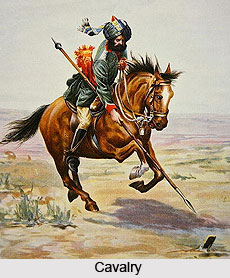 Cavalry in ancient India army played a significant role and they were given special attention. The duties of the superintendent of Horses were also huge. He had to be qualified in all respects for his duties which included knowledge of the feelings of the horses and their qualities. He was also responsible for the supervision of their training. It is interesting to note that the daily routine for a charger, requirements of his rations and other details of stables are not much different in outline from those in force today. The superintendent of the cavalry in ancient Indian army had to ensure that the stables were constructed according to given specifications and proper records kept of each animal according to its type and capabilities. These showed the breed, age, colour, distinguishing marks and the particular group or class.
Cavalry in ancient India army played a significant role and they were given special attention. The duties of the superintendent of Horses were also huge. He had to be qualified in all respects for his duties which included knowledge of the feelings of the horses and their qualities. He was also responsible for the supervision of their training. It is interesting to note that the daily routine for a charger, requirements of his rations and other details of stables are not much different in outline from those in force today. The superintendent of the cavalry in ancient Indian army had to ensure that the stables were constructed according to given specifications and proper records kept of each animal according to its type and capabilities. These showed the breed, age, colour, distinguishing marks and the particular group or class.
During the ancient age, veterinary science was very advanced. Rations for a steed that had bore were laid down in detail. For the first three days it had to be provided with a drink of one prastha of clarified butter. Afterwards it was fed with one prastha of flour and then given oil mixed with various medicines for ten days. According to specifications, the best horse measured thirty-two fingers or angul in the face, its length five times its face, its shank twenty angul and height four times its size of the waist. Rations consisted of one prastha of oil for giving enema - anuvasna, one kudumba of the same for rubbing over the nose, 1000 pala of meadow grass and twice as much of ordinary grass for those of the best variety. Diet of these animals varied according to seasons. The best breeds were from Kham-bhoja, Sindhu, Aratta (Punjab) and Vanayu (Arabia). Those of the middle quality came from Bahlika (Punjab) and Sauvira (Gujarat). The remainder were termed avarah or ordinary.
Great emphasis was laid on the training of the soldier and his mount. This was termed as sannahyam karma. It included circular movement (valgana), slow movement (nichairgata), jumping (langhana), gallop for run and response to signals (neroshtra). The various forms of jumping were kapipluta - jumping like a monkey, ekapluta - sudden jump, ekadapluta - jumping with one leg, bhekapluta - jumping like a frog, kokila samchari - leaping like a cuckoo, urasya - dashing with the chest almost touching the ground and bakasamchari - leaping like a crane. Galloping included kanka - flying like a vulture, varikanka - dashing like a water-duck, mayura - running like a peacock, ardha mayura - half the speed of a peacock, nakula - dashing like a mongoose, ardha nakula - half the speed of a mongoose, varaha - running like a hog and ardha-varaha - half the speed of a hog. The various types of trots were vikrama that is trotting with good speed, bhardrasvasa, meaning trot combined with circular movement, valgita meaning ordinary trot, upakantha and middle most speed, which means upajaya.
Veterinary surgeons were required to apply the required medicines against undue growth or reduction in the body of the horses and also to change their diet according to the seasons. Strict fines were imposed for any carelessness on the part of those whose duty it was to look after. These included loss of wages. In some cases the fine imposed was equal to the value of the animal - patramulya. The human element played a vital part. They were given fancy names, priests invoked the gods and men washed, applied sandal powder, decorated and garlanded their charges twice a day.




















